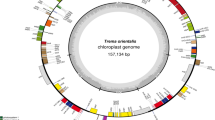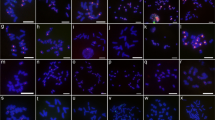Abstract
We characterized a novel giant Gypsy-like retrotransposon, Cyclops, present in about 5000 copies in the genome of Pisum sativum. The individual element Cyclops-2 measures 12 314 bp including long terminal repeats (LTRs) of 1504 bp and 1594 bp, respectively, showing 4.1% sequence divergence between one another. Cyclops-2 carries a polypurine tract (PPT) and an unusual primer binding site (PBS) complementary to tRNA-Glu. The element is bounded by 5 bp target site duplications and harbors three successive internal regions with homology to retroviral genes gag (424 codons) and pol (1382 codons) and an additional open reading frame (423 codons) of unknown function indicating the element's potential capacity for gene transduction. The pol region contains sequence motifs related to the enzymes protease, reverse transcriptase, RNAse H and integrase in the same typical order (5′-PR-RT-RH-IN-3′) known for retroviruses and Gypsy-like retrotransposons. The reading frame of the pol region is disrupted by several mutations suggesting that Cyclops-2 does not encode functional enzymes. A phylogenetic analysis of the reverse transcriptase domain confirms our differential genetic assessment that Cyclops from pea is a novel element with no specific relationship to the previously described Gypsy-like elements from plants. Genomic Southern hybridizations show that Cyclops is abundant not only in pea but also in common bean, mung bean, broad bean, soybean and the pea nut suggesting that Cyclops may be an useful genetic tool for analyzing the genomes of agronomically important legumes.
Similar content being viewed by others
References
Ansorge W, Sproat BS, Stegemann J, Schwager C: A nonradioactive automated method for DNA sequence determination. J Biochem Biophys Methods 13: 315–325 (1986).
Bennetzen JL: The contributions of retroelements to plant genome organization, function and evolution. Trends Microbiol 4: 347–353 (1996).
Bennetzen JL, Kellogg EA: Do plants have a oneway ticket to genome obesity? Plant Cell 9: 1509–1514 (1997).
Birnboim HC, Doly J: A rapid alkaline extraction procedure for screening recombinant plasmid DNA. Nucl Acids Res 7: 1515–1523 (1979).
Bishop JM, Varmus HE: Function and origins of retroviral transforming genes. In: Weiss R, Teich N, Varmus H, Coffin J (eds) RNA Tumor Viruses, pp. 246–356. Cold Spring Harbor Laboratory, Cold Spring Harbor, NY (1985).
Brandes A, HeslopHarrison JS, Kamm A, Kubis S, Doudrick RL, Schmidt T: Comparative analysis of the chromosomal and genomic organization ofTy1copialike retrotransposons in pteridophytes, gymnosperms and angiosperms. Plant Mol Biol 33: 11–21 (1997).
Bureau TE, White E, Wessler SR: Transduction of a cellular gene by a plant retroelement. Cell 77: 479–480 (1994).
Christy RJ, Brown AR, Gourlie BB, Huang RCC: Nucleotide sequences of murine intracisternal Aparticle gene LTRs have extensive variability within the R region. Nucl Acids Res 13: 289–302 (1985).
Clewell DB, Helinski DR: Supercoiled circular DNAprotein complex in Escherichia coli: purification and induced conversion to an open circular DNA form. Proc Natl Acad Sci USA 62: 1159–1166 (1969).
Covey SN: Amino acid sequence homology in gag region of reverse transcribing elements and the coat protein of cauliflower mosaic virus. Nucl Acids Res 14: 623–633 (1986).
Doolittle R, Feng DF, Johnson MS, McClure MA: Origins and evolutionary relationships of retroviruses. Quart Rev Biol 64: 1–30 (1989).
Doyle JJ, Lavin M, Bruneau A: Contributions of molecular data to Papilionoid legume systematics. In: Soltis PS, Soltis DE, Doyle JJ (eds) Molecular Systematics of Plants, pp. 223–251. Chapman and Hall, New York and London (1992).
Feinberg AP, Vogelstein B: Atechnique for radiolabeling DNA restriction endonuclease fragments to high specific activity. Ann Biochem 137: 266 (1984).
Felsenstein J: PHYLIP manual, version 3.5. University of Washington, Seattle (1993).
Flavell AJ, Dunbar E, Anderson R, Pearce SR, Hartley R, Kumar A: Ty1copia group retrotransposons are ubiquitous and heterogeneous in higher plants. Nucl Acids Res 20: 3639–3644 (1992).
Flavell AJ, Smith DB, Kumar A: Extreme heterogeneity of Ty1copia group retrotransposons in plants. Mol Gen Genet 231: 233–242 (1992).
Friesen PD, Nissen MS: Gene organization and transcription of TED, a lepidopteran retrotransposon integrated within the baculovirus genome. Mol Cell Biol 10: 3067–3077 (1990).
Frischauf AM, Lehrbach H, Poustka A, Murray N: Lambda replacement vectors carrying polylinker sequences. J Mol Biol 170: 827–842 (1983).
Grandbastien MA: Retroelements in higher plants. Trends Biochem Sci 8: 103–108 (1992).
Hansen LJ, Sandmeyer SB: Characterization of a transpositionally active Ty3 element and identification of the Ty3 integrase protein. J Virol 64: 2599–2607 (1990).
Higgins DG, Bleasby AJ, Fuchs R: CLUSTAL V: improved software for multiple sequence alignment. CABIOS 8: 189–191 (1992).
Hu W, Das OP, Messing J: Zeon1, a member of a new maize retrotransposon family. Mol Gen Genet 248: 471–480 (1995).
Inouye S, Yuki S, Saigo K: Complete nucleotid sequence and genome organization of a Drosophila transposable element, 297. Eur J Biochem 154: 417–425 (1986).
Jin JK, Bennetzen JL: Integration and nonrandom mutation of a plasma membrane proton ATPase gene fragment within the Bs1 retroelement of maize. Plant Cell 6: 1177–1186 (1994).
Johnson MS, McClure MA, Feng DF, Gray J, Doolittle RF: Computer analysis of retrovirus pol genes: assignment of enzymatic function to specific sequences and homologies with nonviral enzymes. Proc Natl Acad Sci USA 83: 7648–7652 (1986).
Kingsman AJ, Kingsman SM: Ty: a retroelement moving forward. Cell 53: 333–334 (1988).
Kossack DS: The IFG7 copialike element: characterization of a transposable element present in high copy number in Pinus and a history of the pines using IFG as a marker. University Microfilms, University of Michigan, Ann Arbor (1989).
Kumar A: The adventures of the Ty1copia group of retrotransposons in plants. Trends Genet 12: 41–43 (1996).
Lankenau DH, Huijser P, Jansen E, Miedema K, Hennig W: Micropia: a retrotransposon of Drosophila combining structural features of DNA viruses, retroviruses and nonviral transposable elements. J Mol Biol 204: 233–246 (1988).
Lee D, Ellis THN, Turner L, Hellens RP, Cleary WG: A copialike element in Pisum demonstrates the uses of dispersed repeated sequences in genetic analysis. Plant Mol Biol 15: 707–722 (1990).
Levin HL: It's prime time for reverse transcriptase. Cell 88: 5–8 (1997).
Levin HL: An unusual mechanism of selfprimed reverse transcription requires the RNase H domain of reverse transcriptase to cleave an RNA duplex. Mol Cell Biol 16: 5645–54 (1996).
Levin HL, Weaver DC, Boeke JD: Two related families of retrotransposons from Schizosaccharomyces pombe. Mol and Cell Biol 10: 6791–6798 (1990).
Li WH, Luo CC, Wu CI: Evolution of DNA sequences. In: McIntyre RJ (eds) Molecular evolutionary genetics, pp. 1–94. Plenum, New York (1985).
Marlor RL, Parkhurst SM, Corces VG: The Drosophila melanogaster gypsy transposable element encodes putative gene products homologous to retroviral proteins.Mol Cell Biol 6: 1129–1134 (1986).
Marquet R, Isel C, Ehresmann C, Ehresmann B: tRNAs as primer of reverse transcriptases. Biochimie 77: 113–124 (1995).
McHale MT, Roberts IN, Noble SM, Beaumont C, Whitehead MP, Seth D, Oliver RP: Cft1: an LTRretrotransposon in Cladosporium fulvum, a fungal pathogen of tomato. Mol Gen Genet 233: 337–347 (1992).
Michaille JJ, Mathavan S, Gaillard J, Garel A: The complete sequence of mag, a new retrotransposon in Bombyx mori. Nucl Acids Res 18: 674 (1990).
Palmgren MG: Capturing of host DNA by a plant retroelement: Bs1 encodes plasma membrane H+ATPase domains. Plant Mol Biol 25: 137–140 (1994).
Pélissier T, Tutois S, Deragon JM, Tourmente S, Genestier S, Picard G: Athila, a new retroelement from Arabidopsis thaliana. Plant Mol Biol 29: 441–452 (1995).
Purugganan MD, Wessler SR: Molecular evolution of magellan, a maize Ty3/gypsylike retrotransposon. Proc Natl Acad Sci USA 91: 11674–11678 (1994).
Rothnie HM, McCurrach KJ, Glover LA, Hardman N: Retrotransposonlike nature of Tp1 elements: implications for the organisation of highly repetitive, hypermethylated DNA in the genome of Physarum polycephalum. Nucl Acids Res 19: 279–86 (1991).
Saigo K, Kugimiya W, Matsuo Y, Inouye S, Yoshioka K, Yuki S: Identification of the coding sequence for a reverse transcriptaselike enzyme in a transposable genetic element in Drosophila melanogaster. Nature 312: 659–661 (1984).
Saitou N, Nei M: The neighborjoining method: a new method for reconstructing phylogenetic trees. Mol Biol Evol 4: 406–425 (1987).
Sambrook J, Fritsch EF, Maniatis T: Molecular cloning – A laboratory manual. Cold Spring Harbor Laboratory Press, Cold Spring Harbor (1989)
Sanger F, Nicklen S, Coulson AR: DNA sequencing with chainterminating inhibitors. Proc Natl Acad Sci USA 74: 5463–5467 (1977).
Scheinker VS, Lozovskaya ER, Bishop JG, Corces VG, Evgenév MB: A long terminal repeatcontaining retrotransposon is mobilized during hybrid dysgenesis in Drosophila virilis. Proc Natl Acad Sci USA 87: 9615–9619 (1990).
Sentry JW, Smyth DR: An element with long terminal repeats and its variant arrangements in the genome of Lilium henryi. Mol Gen Genet 215: 349–354 (1989).
Smyth DR, Kalitsis P, Joseph JL, Sentry JW: Plant retrotransposon from Lilium henryi is related to Ty3 of yeast and thegypsy group of Drosophila. Proc Natl Acad Sci USA 86: 5015–5019 (1989).
Springer MS, Britten RJ: Phylogenetic relationships of reverse transcriptase and RNase H sequences and aspects of genome structure in the gypsy group of retrotransposons. Mol Biol Evol 10: 1370–1379 (1993).
Springer MS, Davidson EH, Britten RJ: Retrovirallike elements in a marine invertebrate. Proc Natl Acad Sci USA 88: 8401–8404 (1991).
Sprinzl M, Steegborn C, Hubel F, Steinberg S: Compilation of tRNA sequences and sequences of tRNA genes. Nucl Acids Res 24: 68–72 (1996).
Tanda S, Shrimpton AE, LingLing C, Itayama H, Matsubayashi H, Saigo K, tobari YN, Langley CH: Retroviruslike features and site specific insertions of a transposable element, tom, in Drosophila ananassae. Mol Gen Genet 214: 405–411 (1988).
Temin HM: Origin of retroviruses from cellularmovable genetic elements. Cell 21: 599–600 (1980).
Torruella M, Gordon K, Hohn T: Cauliflower mosaic virus produces an aspartic proteinase to cleave its polyproteins. EMBO J 8: 2819–2825 (1989).
Varmus H, Brown P: Retroviruses. In: Berg DE, Howe MM (eds) Mobile DNA, pp. 53–108. American Society for Microbiology, Washington, DC (1989).
Voytas DF, Cummings MP, Konieczny A, Ausubel FM, Rodermel SR: copialike retrotransposons are ubiquitous among plants. Proc Natl Acad Sci USA 89: 7124–7128 (1992).
White SE, Habera LF, Wessler SR: Retrotransposons in the flanking regions of normal plant genes: a role for copialike elements in the evolution of gene structure and expression. Proc Natl Acad Sci USA 91: 11792–11796 (1994).
Wolfe KH, Li WH, Sharp PM: Rates of nucleotide substitution vary greatly among plant mitochondrial, chloroplast, and nuclear DNAs. Proc Natl Acad Sci USA 84: 9054–9058 (1987).
Xiong Y, Eickbush TH: Origin and evolution of retroelements based on their reverse transcriptase sequences. EMBO J 9: 3353–3362 (1990).
Yoshioka K, Honma H, Zushi M, Kondo S, Togashi S, Miyake T, Shiba T: Viruslike particle formation of Drosophila copia through autocatalytic processing. EMBO J 9: 535–541 (1990).
Yuki S, Inouye S, Ishimaru S, Saigo K: Nucleotide sequence characterization of a Drosophila retrotransposon, 412. Eur J Biochem 158: 403–410 (1986).
Zhang DX: Structure and evolution of genes encoding chloroplast (GapA) and cytosolic (GapC) glyceraldehyde3phosphate dehydrogenases and a newretrotransposon(Tps1) of pea. Ph.D. thesis: University Joseph Fourier, Grenoble, France (1991).
Author information
Authors and Affiliations
Rights and permissions
About this article
Cite this article
Chavanne, F., Zhang, DX., Liaud, MF. et al. Structure and evolution of Cyclops: a novel giant retrotransposon of the Ty3/Gypsy family highly amplified in pea and other legume species. Plant Mol Biol 37, 363–375 (1998). https://doi.org/10.1023/A:1005969626142
Issue Date:
DOI: https://doi.org/10.1023/A:1005969626142




